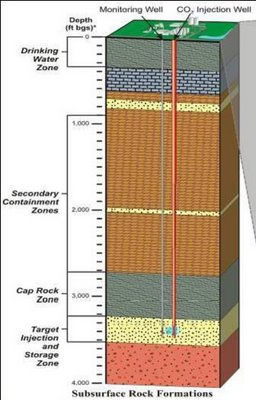|
SUNDAY EDITION May 11th, 2025 |
|
Home :: Archives :: Contact |
 |
Practice RunPeter McKenzie-BrownEmail: pmbcomm@hotmail.com languageinstinct.blogspot.com June 24th, 2009  H2S re-injection a rehearsal for carbon storage program. This article appears in the May 2009 issue of Alberta Oil Magazine Oil and gas operations produce two kinds of acid gases – hydrogen sulfide (H2S) and carbon dioxide (CO2). The former is usually stripped from the gas stream and converted into sulfur. Tom Byrnes, a reservoir engineering manager at the Energy Resources Conservation Board, says the sulfurous impurity is sometimes just stripped from the gas and re-injected underground. “It’s usually an economic question. There may be small volumes of H2S in the gas stream, or the infrastructure [to strip out sulfur] may not be in place to make it practical.” In Alberta, the board regulates all disposals through disposal wells and first approved an H2S re-injection project in 1989. Both of these acid gases are routinely stripped from natural gas for re-injection, as appropriate. “But the smaller the concentration of H2S or CO2 there is in the gas stream, the more expensive it is to get it out. It’s a problem of diminishing returns,” Byrnes says. If H2S can have commercial value as a source of sulfur, CO2 is frequently injected into operating oilfields to stimulate production. This is not new. Carbon dioxide has long been used for enhanced oil recovery, to urge additional barrels out of elderly oilfields. One such project has been operating in the 50-year-old Weyburn oilfield in southern Saskatchewan for nine years. The project uses a 330-kilometer pipeline to transport carbon dioxide captured at the Great Plains Coal Gasification plant, which manufactures methane from coal near Beulah, North Dakota. As it keeps oil flowing from this aging field, each year the EnCana-operated project disposes of about 1.5 million tonnes of carbon dioxide emissions. This is environmentally beneficial, since CO2 is both an acid gas that can acidify water and a greenhouse gas that can trap heat within Earth’s ionosphere. While EnCana’s Weyburn project is profitable in its own right, most industrial operators would find it economically prohibitive to strip CO2 from industrial processes for sequestration down disposal wells. Those economics changed profoundly last July when Alberta Premier Ed Stelmach announced a $2-billion commitment of government assistance to advance carbon capture and sequestration (CCS) technologies in the province. Provincial authorities are now sifting through a dozen applications for funding, and will announce the successful projects as decisions are made. Alberta’s involvement follows a gestation period of deep study, including a provincial policy paper which observed that “Alberta has a unique opportunity to implement carbon capture and storage to substantially reduce our greenhouse gas emissions. CO2 emissions can be captured where they are produced, transported and stored in geological formations (such as depleted oil and gas reservoirs, coal beds and deep saline aquifers) that may be located hundreds of kilometers away. Ultimately, CO2 capture and storage technologies provide the province with the greatest potential to substantially reduce greenhouse gas emissions while, at the same time, retaining our ability to produce and provide energy to the rest of the world.” According to that policy paper, Alberta is counting on CCS to meet 70 per cent of its long-term greenhouse reduction targets. If the five provincially subsidized projects – likely to cost a billion dollars each–all go into operation, they would collectively reduce emissions by up to five million tonnes annually. That is likely just the beginning for large-scale underground carbon sequestration projects in the province. While five
million tonnes annually of sequestered CO2 may seem like a large
number, it’s barely a whiff of what’s possible. Over four decades,
Alberta’s greenhouse gas emissions plan targets a 200-million tonne cut
in emissions, but only compared to a do-nothing scenario. That volume
is a bare indication of the huge volumes of waste – solids, liquids,
effluents and emissions – generated by one of the world’s leading
petroleum producers.
|
| Home :: Archives :: Contact |
SUNDAY EDITION May 11th, 2025 © 2025 321energy.com |
|